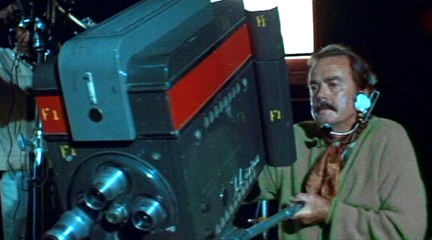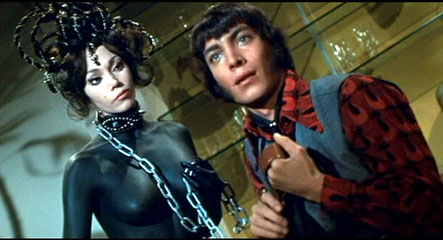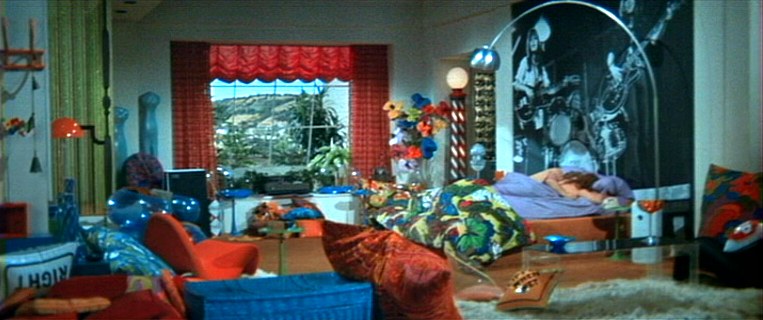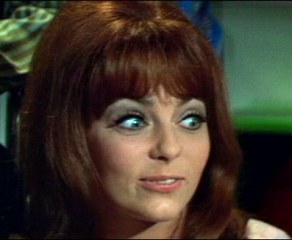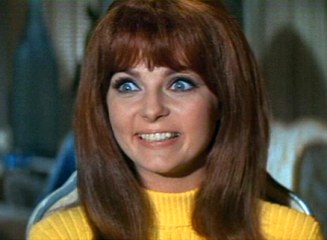Beyond the Valley of the Dolls (1970) from Tuna and Johnny Web (Uncle Scoopy; Greg Wroblewski) |
|
Tuna's notes
This is the legendary Russ Meyer film written by Roger Ebert - the one accomplishment he would most like to forget. Yes, it is every bit as bad as it is purported to be. The photography is technically sound, demonstrating Meyer's beginnings as an army photographer, but there are major problems elsewhere. For one thing, the dialogue is the most flowery, stilted and unnatural I have ever heard. The other main problem is the plot - every silly minute of it. The story starts out conventionally. A three-girl rock band and their manager come to Hollywood to "make it big." They meet the right people, and land a big recording contract, but then run into sex, drugs and sleazebags. This version of Hollywood is populated by a collection of misfits, mostly bisexual, who seem to do nothing but have sex and take drugs. In the last third of the film, the plot finally starts moving, with the strangest series of events ever strung together on celluloid. These plot twists, as well as much of Ebert's dialogue, made me laugh out loud. The film does have a very high nipple count, as you would expect from Meyer, who was the epitome of the "tit man," but that count might have been much higher. The film was after an R rating, but got saddled with an X, probably because Russ Meyer directed it. According to Roger Ebert, there was a good deal of harder X footage that Meyer wanted to include after the MPAA gave them the X anyway, but the studio didn't want any further delays before getting it into the theaters. The film now has a cult following, and deservedly so. This is one of the most entertaining bad movies ever made! TV Guide called it "an outrageously entertaining cult classic, and probably one of the most bizarre movies ever produced by a major Hollywood studio."
|
|
|
Scoop's notes
- Roger Ebert, co-author of Beyond the Valley of the Dolls
Well, I have to agree with Mr. Ebert in some respects. Russ Meyer (above, making a cameo appearance in Beyond the Valley of the Dolls) has definitely influenced our popular culture in a unique way. I had a friend in Dallas who was a pretty fair amateur filmmaker. One of his comedy projects was a faux-promotional cassette produced by a fictitious film studio in order to show off their product line for the upcoming year. One of the touted films was "Russ Meyer's The Alamo," which was pretty much like any other version of The Alamo except that Davy Crockett had really big tits. Everybody got the joke. Beyond the Valley of the Dolls is a special film, in much the same sense that we call mentally handicapped people "special." Do you remember when Tom Green divorced Drew Barrymore because she was "too immature." Think about that. How immature do you have to be before Tom Green notices? In all of my lifetime, the only parallel "think about that" I can recall is when Beyond the Valley of the Dolls was threatened with a lawsuit from Jacqueline Susann (author of Valley of the Dolls) because the association with it hurt her reputation. Think about that. How bad does something need to be before Jacqueline Susann is embarrassed to be associated with it? Truthfully, this film is a lot of fun in a lot of very eccentric ways. Of course, it is not really a sequel to Susann's Valley of the Dolls, but a send-up of that film and all other "innocent chicks corrupted by the big city" movies. It was created in unique circumstances. When I reviewed the great masterpiece Andrej Rublov, I noted that it was a totally unique film in that the director was given an unlimited amount of time, money and freedom to create whatever he cared to create, irrespective of its potential profitability. It was to be the complete cinematic summary of the Russian character and history, and the State supported it 100%. (Well, at least until Khrushchev was deposed.) Such a situation will probably never happen again. The same can probably be said of Beyond the Valley of the Dolls. Fox gave a substantial budget to a known pornographer and a fledgling screenwriter, told them to create a spoof of one of its own biggest hits, and then stayed hands-off until it was finished. I don't see that particular carousel comin' 'round no more. I'll bet this is is first time Beyond the Valley of the Dolls has ever been compared to Andrej Rublov.
|
|
|
"Hey, Scoop, are you sure it was supposed
to be a spoof? I mean it's all straight-faced an' all?" Well, I'll tell ya. the melodramatic plot twists are punctuated with organ chords, two of the lovers run through a meadow in slow motion, and one of the characters tells another, "You will drink the black sperm of my vengeance." Oh, yeah, and some of the camera angles should be accompanied by an announcer saying, "Tune in tomorrow ... same Bat-time, same Bat-channel." (Right) So you tell me. Spoof or not? |
|
|
People have forgotten that it was quite profitable. The budget was less than a million dollars (which still seemed a fortune to Russ Meyer), and it grossed about ten times its cost. A total box office of nine million dollars doesn't sound that impressive on the surface, until you adjust for the fact that the film was made in 1970, when the average ticket price was $1.55. Translated to 2005 terms, this film grossed about forty million dollars - more than The Constant Gardener or A History of Violence. If it was pretty good in 1970, it is better now, because it gives us some real insight into the period. We have seen the 70s spoofed in recent films like Anchorman and Austin Powers, and we have seen 70s filmmaking spoofed in recent films like Undercover Brother, but Beyond the Valley of the Dolls allows us to creep deep inside the era to see how 1970 made fun of itself and its films. Check this out:
So you cats have to prepare before popping this in the DVD player. Plug in your lava-lamp, tack up your black-light posters, grow out your sideburns, wiggle into your fruit-boots, and put on some tie-dyed jeans and a mint-green flower-print shirt with some jumbo-ass lapels, 'cuz you're gonna get groovy - psychedelically speaking. If you're inviting your chick over to watch, tell her to put on her tight leather micro-skirt and her white knee-length boots. Make sure she wraps a bright orange scarf around her neck, and grabs her love-beads, before riding over to your crash pad in her chartreuse and purple VW camper. All kidding aside, I think this film is pretty effective at what it sets out to do, and some of the touches are absolutely brilliant- even subtle in some cases. The incidental classical music used for punctuation in this film is very clever. Wagner, Dukas, and Borodin provide the right strains at the right times - right for comedy, that is - and the musical accompaniment actually made me laugh out loud at two scenes. The film also maintains a quiet running joke with the musical group consisting of the three starring girls. It's just a small "chick-band," only two guitars and some drums, but when they play live on stage, or even in impromptu concerts at parties, they are accompanied by enough horns to populate The Tijuana Brass and the Tommy Dorsey Orchestra. Talk about a "big" sound from three girls! Despite this mysterious circumstance, nobody in the audience ever seems curious about where the trumpet and trombone music is coming from! Some of the film's other elements are less effective:
I know what you're thinking. "What the hell do those words have to do with this movie?" I suppose you think they came out of left field, just like Shoeless Joe Jackson, the subject of that poem. Be patient. There is a connection, albeit my usual dim-witted one. Those were Nelson Algren's words about the infamous Black Sox, another Chicago phenomenon decades distant from the writing of Roger Ebert. Were the 1919 Chicago White Sox a bad team? After all, they were trying to lose a World Series, and they did, so they succeeded at failure. The same point applies to this movie. Beyond the Valley of the Dolls is the "Black Sox" of movies. It tries to be bad, and it is. Does that make it a bad movie or a good one? A score of long years after, let's just say they made a great failure, and let it go at that. |
|
|
||||
|
||||
